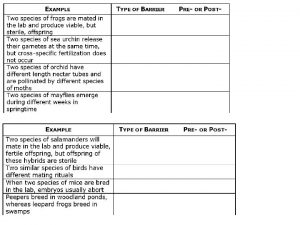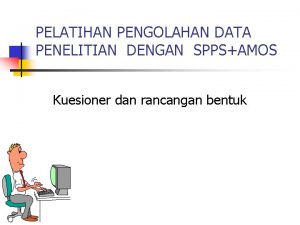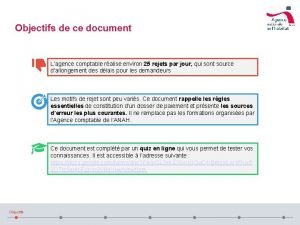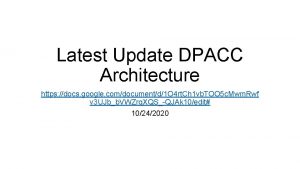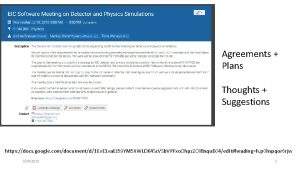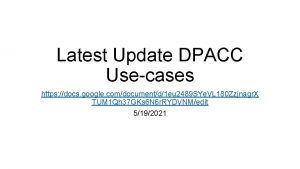Agreements Plans Thoughts Suggestions https docs google comdocumentd1







- Slides: 7

Agreements + Plans Thoughts + Suggestions https: //docs. google. com/document/d/1 Ev. E 1 va. EJ 59 YM 5 XWLDK 4 Sc. VSb. VPFxo. Ohpz 2 OI 8 nqu. B 04/edit#heading=h. p 0 hspqor 6 rjw 9/24/2019 1

Discussion - agreements, plans & actions • agree on detector naming conventions • agree on G 4 C++ as the basis of detector description for now (access to all G 4 volumes including new recommended ones like tessellated solids) • 3 of the 4 approaches (not Eic. Root) can work with C++ G 4 detector descriptions • make the (inevitable) framework-specific adaptation layer needed around the C++ as thin as possible • agree on how structs for parameters are defined and managed • ‘numbers in the code’ is not necessarily a bad thing if they are managed carefully. Coming to commonality on a more long term solution like DB is a bigger issue (and not on Thomas’ ‘now’ list) • agree on API/class design for sensitive detector stepping action/digi • agree on hits output structure - can we agree on that? depends on detector and how reco is handled afterwards • even without this we’ve agreed on enough to satisfy Thomas • common repository we point people to when they come along with a detector model to plug in • deliverable: the simple document and template(s) we give to the user on how to implement and integrate their new subdetector in the detector concepts via our common Geant 4 infrastructure • time frame? • by end of the fiscal year (end Sep), have made the agreements concrete in a document • for implementation…? • deliverable: an updated/agreed document of the requirements • need followup meeting on participation, who will do what by when • what resources do we have and how do we use them 9/24/2019 2

agree on detector naming conventions Everything is derived from a “detector name”, e. g. CEMC (compact EMCal) HCALIN (inner Hcal), … In Fun 4 All the output nodename(s) for that detector depend on this name Subsequent modules use the detector name to identify what they work on (needed for generic modules) Hits can be saved under this name Exchanging e. g. one CEMC implementation by another but keeping the same name is possible, no changes in the setup of the subsequent generic modules à No hardcoded name, name needs to be adjustable in a macro or configuration (and the usual – no spaces or special characters in name) Enables also running detectors “in parallel” for testing 9/24/2019 3

• agree on G 4 C++ as the basis of detector description for now (access to all G 4 volumes including new recommended ones like tessellated solids) • make the (inevitable) framework-specific adaptation layer needed around the C++ as thin as possible As a matter of fact – we have ROOT on one side (Fun 4 All) and Geant 4 on the other (g 4 e), that has repercussions all over the place when it comes to adapting code Technically G 4 implementation has to provide a construct method which builds the detector Our approach is to have multiple construct methods which are chained up G 4 e approach is to have one with a hierarchy under it àBut in principal code can be easily transferred from one to the other world with minimum effort by porting (cutting and pasting) the construct method of a given detector 9/24/2019 4

• agree on how structs for parameters are defined and managed • ‘numbers in the code’ is not necessarily a bad thing if they are managed carefully. Coming to commonality on a more long term solution like DB is a bigger issue (and not on Thomas’ ‘now’ list) We do have an easy parameter class (name -> value) and a collection (index, parameter class) Each detector has their own Can be saved in postgres Db or as xml file (with the xml caveat about identical readback!) both use ROOT for this (stream out the class), can be expanded to reading generic xml or json The devil is in how to change them to play/test/develop: Editing large xml files is painful and error prone à Need a way to override them on the command line Parameters must be saved on the output, We need a hierarchy (last one to set the param wins): so you know what was used and later 1. parameters have explicit defaults in the code* modules can access this information (e. g. 2. parameters are read from DB (if enabled) sampling fraction in our inner hcal when 3. from xml file changing the absorber material) 4. macro setting** * makes this easily adaptable to hardcoded implementations ** You really want this for development Important: typos in parameter names used in macros, DB or xml file must be detected Compare name of parameter to name in default setting in module 9/24/2019 Nothing too fancy in this class, should be easily portable but hierarchy implementation deeply entangled with framework. Usability without ROOT needs to be investigated 5

• agree on API/class design for sensitive detector stepping action/digi • agree on hits output structure - can we agree on that? depends on detector and how reco is handled afterwards • Stepping action API is given by GEANT 4 • Stepping action is intimately connected to the framework and further processing, it is the interface from G 4 to the framework (where the interface can be a file). • Hit pre-processing (what fields/values, Birks correction, position dependent corrections, eloss calculations) can be copied with minimum effort • Hit object itself is part of the data model of a framework, any framework needs the freedom to change it • There should be a way to mark detectors active (use GEANT 4 sensitive detector or other means) • There should be a way to digitize the hits (but this is part of the reconstruction) What we should agree on is support for converters for hits (raw hits in the detectors). In the end it is a loop over input structure(s) filling some output structure. 9/24/2019 6

common repository we point people to when they come along with a detector model to plug in Use of continuous integration is must (with many contributors you just need this) Administration, Maintenance? Removal of obsolete code Adapting to e. g. new G 4, ROOT versions Pull request mechanism Framework specific interfaces 9/24/2019 7
